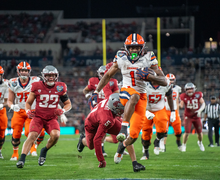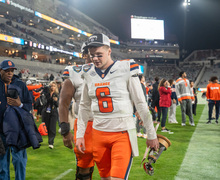Graduate transfer rule change shaking up college basketball 5 years after implementation
Jessica Sheldon | Staff Photographer
Done and one: The graduate transfer rule is still shaking up college basketball world five years after its implementation
When Andrew White sits down to watch a college basketball game on TV, he finds the announcers talking about him. Even though Syracuse wasn’t playing, their discussions centered on players like White.
They explained the NCAA’s graduate transfer rule, which allows players who have received their undergraduate degree to transfer without sitting out a year. Some coaches and players like the rule. Others don’t. But many of them, such as the announcers, haven’t been in White’s shoes.
“There are a lot of people who have an issue with it,” White said, “until they have an ability to get that player that they can add to their roster last minute. … I’m kind of Mr. Grad Transfer himself. Hey, I mean, that’s the rule. I followed the rule.”
As coaches gain familiarity with the rule, more teams nationwide are plugging in players to immediately fill holes in between years. Five years after implementing the rule, five Atlantic Coast Conference teams this season — including Virginia, which kicked Auburn transfer Austin Nichols off the team before the year — have dipped into the graduate transfer market. After never previously taking a graduate transfer, SU head coach Jim Boeheim has added two this year in White and John Gillon.
How the rule is viewed varies. For coaches in high-major conferences, it provides an avenue to restock. For coaches in mid-major conferences, their star players could get poached away if they graduate with a season of eligibility left. For players who normally would have to sit out a year for transferring, per the NCAA rule, it’s a way to play at a school with more exposure or competition.
“It’s something that a lot of schools have tried to take advantage of,” Boeheim said. “Some have worked out, and some have been difficult.”
Syracuse, for example, lost Malachi Richardson to the NBA after his freshman season and after the 2016 recruiting cycle was already complete. White stepped in to man the same small forward position the day before fall classes began and now leads the Orange in points. Had Richardson stayed, Boeheim said, SU probably wouldn’t have looked for graduate transfers.
Boeheim was surprised by how long it took White and Gillon to acclimate to his offensive and defensive systems. He’s said it can be easier to work with freshmen because they haven’t yet developed counterproductive habits. Either way, the two graduate transfers are among SU’s most important players this season.
Coaches of mid-major programs, though, occasionally get their players cherry-picked in the offseason. Gillon said he probably wouldn’t have transferred to SU if he had had to sit out a year. But the rule states that once he graduated from Colorado State, he could transfer with no strings attached.
“I don’t see what’s the big issue for graduate transfers,” Georgia Tech head coach Josh Pastner said. “There’s nothing wrong with it.”
One byproduct of this rule, Pittsburgh coach Kevin Stallings said, is that mid-major programs have grown hesitant to pay for players’ summer school since they may fear a player who graduates early and leaves. He understands why a program would stop funding summer school, but that limits the player academically. On the flip side, many of the players who transfer for graduate programs never complete their multi-year requirements since they’ll play only one season.
The academic side has muddled as players spin an early graduation into a more desirable professional basketball launching pad.
Wake Forest head coach Danny Manning, who coached at Tulsa from 2012-14, has seen both sides. He experienced the fear that Stallings mentioned. This season, Manning has taken on Austin Arians, a graduate transfer from Milwaukee.
“If you’re just thinking in an idealistic world,” North Carolina head coach Roy Williams said, “it’s not a bad situation for that individual. But looking at the big picture, I think it’s a bad move.”
That’s because of the way the mid-major programs could be affected. After what’s likely a four-year investment in a player, he can bail right as he peaks.
Another way major programs gain from adding graduate transfers is they help a team fill out its roster (e.g. Syracuse after losing Richardson). It also doesn’t affect recruiting in future years. The commitment is for only one season, so a junior in high school doesn’t have to worry about his scholarship spot. And instead of filling out the roster with players from high school, more experienced players are more desirable, Louisville head coach Rick Pitino said.
That’s a contrast from Boeheim’s sentiment, illustrating how murky the situation can be and how much of one’s view is based on perspective. As chatter has increased, there’s a growing push for the NCAA to change the rule. But regardless of what people around the sport have said, both White and Gillon agree that having the chance to play one final season at a school of their choice benefitted their careers.
“I don’t like the rule, but the rule is there, and if you can help your team, you try to help your team,” Boeheim said. “We certainly helped our team with Johnny and with Andrew so that’s what we’re looking to do.”
Published on February 6, 2017 at 11:48 pm
Contact Paul: pmschwed@syr.edu | @pschweds





